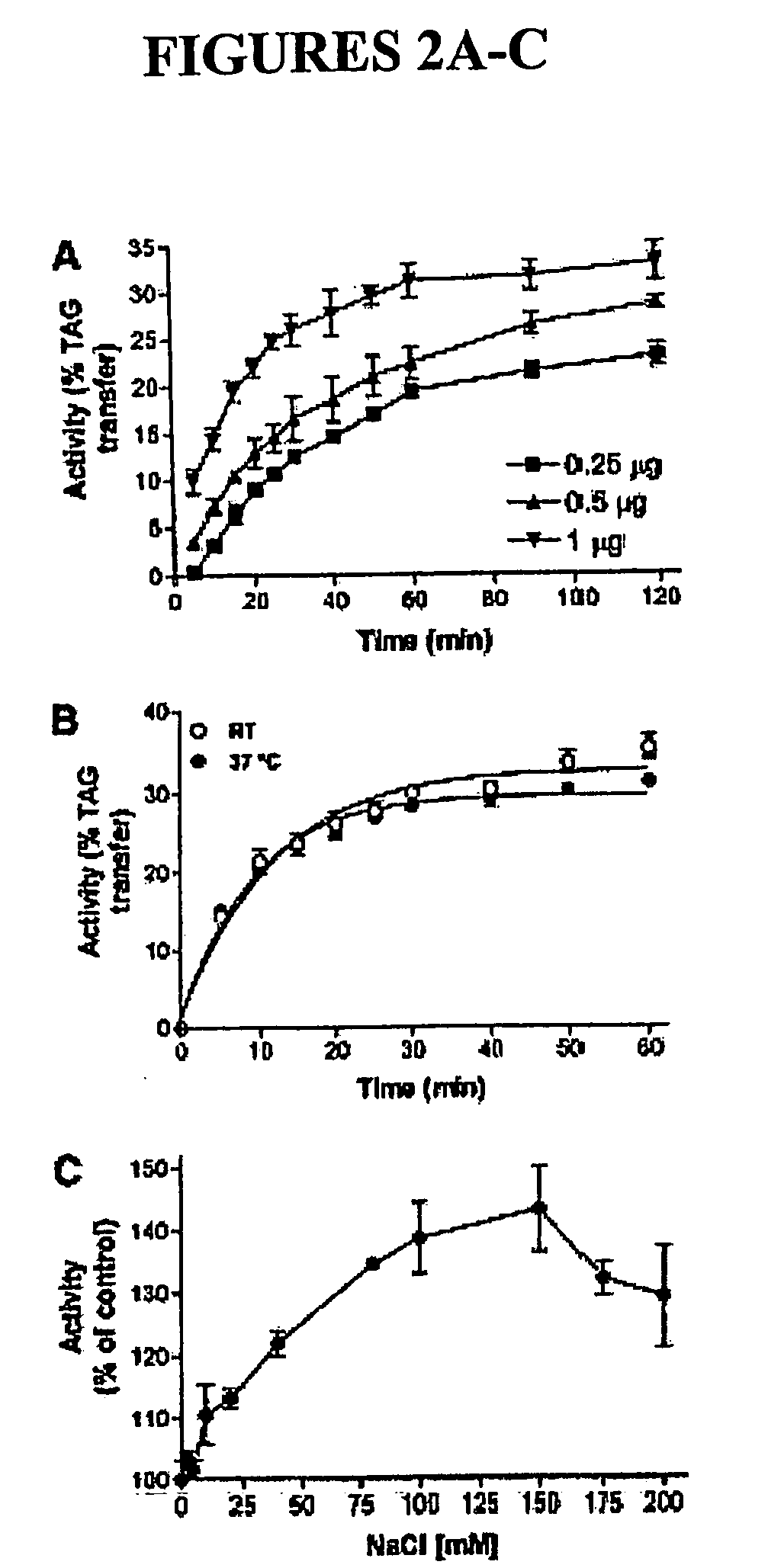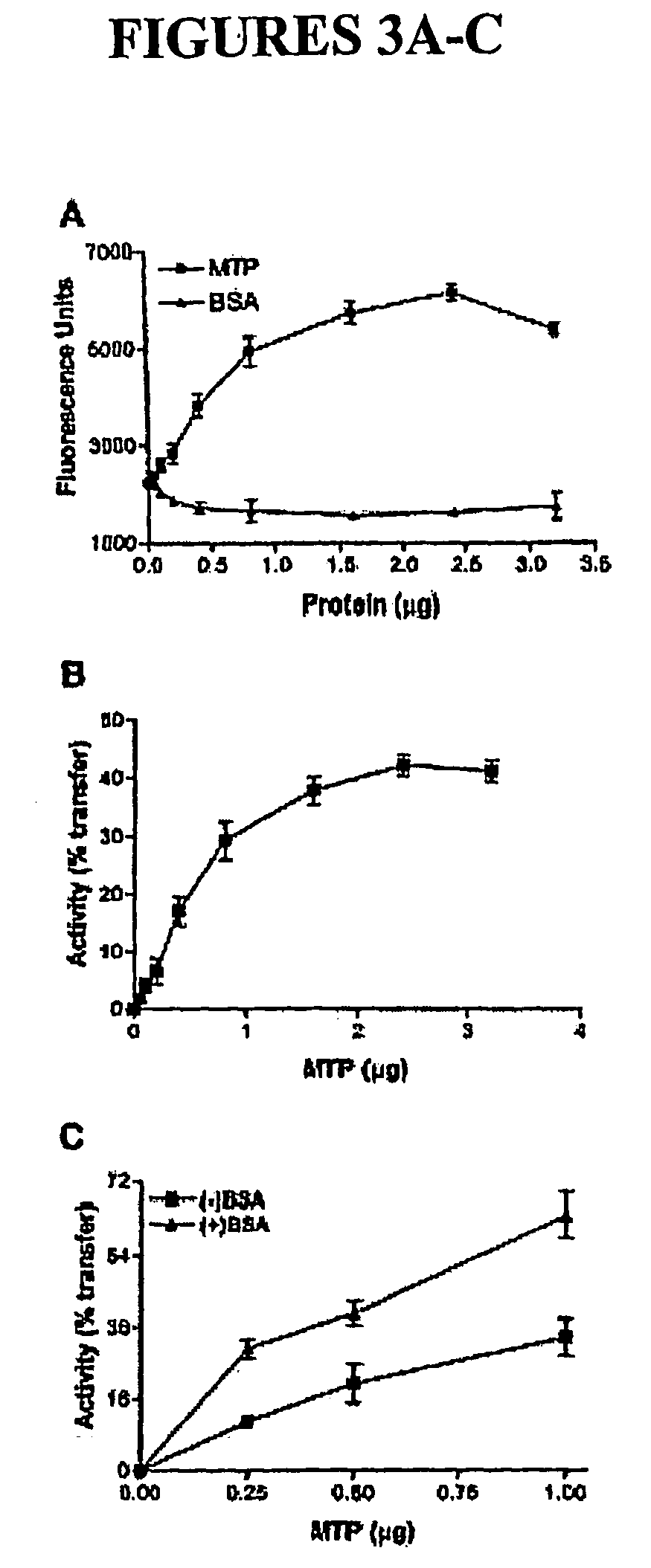Fluoresence assay for mtp activity
a technology of fluoresence assay and activity, which is applied in the direction of fluorescence/phosphorescence, biochemistry apparatus and processes, instruments, etc., can solve the problems of labor-intensive and time-consuming procedures, and the difficulty of automating
- Summary
- Abstract
- Description
- Claims
- Application Information
AI Technical Summary
Benefits of technology
Problems solved by technology
Method used
Image
Examples
example i
Materials and Methods
Materials
[0076] MTP was purified from bovine liver using the radioactivity assay (20, 21) and has been used previously (2429). PC and TAG were from Avanti Lipids (Alabaster, Ala.). Fluorescence (nitrobenzoxadiazole)-labeled TAG was from Molecular Probes (Eugene, Oreg.). Vesicles containing fluorescence-labeled cholesteryl ester (CE) and phospholipid (PL) were from Roar Biomedical, Inc. (New York, N.Y.) and Cardiovascular Target, Inc. (New York, N.Y.), respectively. Isopropanol and other chemicals were from Sigma Chemical Co. (St. Louis, Mo.). Acceptor vesicles were prepared as described by Wetterau and associates (20, 21, 30-32). Donor vesicles were also prepared according to their procedure except that cardiolipin was omitted and radiolabeled TAGs were replaced with fluorescence-labeled TAGs. Known amounts of fluorescent lipids were diluted in isopropanol to generate a standard curve, and amounts of labeled lipids in vesicles were determined after their disr...
example ii
Optimization of Assay Conditions
[0082] To standardize a fluorescence assay for MTP, TAGs were incorporated into small unilamellar PC vesicles (donor vesicles). It was anticipated that the encapsulation would result in the quenching of the fluorophore. Indeed, disruption of increasing amounts of donor vesicles with iso-propanol resulted in enhanced measurable fluorescence (FIG. 1A, total). This represents the total amounts of fluorophore present in the vesicles. Before disruption, this fluorescence is not detectable because it is quenched in vesicles. It was also envisioned that donor vesicles would be stable and would not release the fluorophore in the absence of MTP. To determine the stability, donor vesicles were mixed with acceptor vesicles and the fluorescence in the absence of MTP was measured after 30 min (FIG. 1A, blank). The blank fluorescence values ranged between 13% and 19% [15.7±2.7% (average SD; n =3)] of the totals. The blank values probably represent the small leakag...
PUM
 Login to View More
Login to View More Abstract
Description
Claims
Application Information
 Login to View More
Login to View More - R&D
- Intellectual Property
- Life Sciences
- Materials
- Tech Scout
- Unparalleled Data Quality
- Higher Quality Content
- 60% Fewer Hallucinations
Browse by: Latest US Patents, China's latest patents, Technical Efficacy Thesaurus, Application Domain, Technology Topic, Popular Technical Reports.
© 2025 PatSnap. All rights reserved.Legal|Privacy policy|Modern Slavery Act Transparency Statement|Sitemap|About US| Contact US: help@patsnap.com



